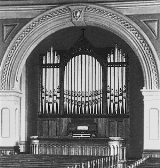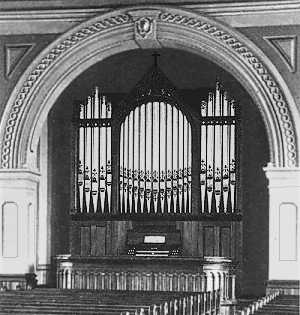
Johnson Organs
Encyclopedia
The William A. Johnson Organ Company of Westfield, Massachusetts
, which later became Johnson & Son Organ Company, was a highly respected firm which built 860 pipe organs throughout the United States and in Canada and Bermuda. The company operated from 1844 through 1898. All Johnson organs were completely mechanical (tracker action
) organs, with Barker lever
tracker-pneumatic actions utilized in larger organs after 1871.
was operating a contracting business in Westfield, Massachusetts. While he was completing the construction of a new church building for his own Westfield church, an organ builder of the firm E. and G.G. Hook & Hastings arrived with wagon loads of parts, pipes and materials which were to be installed in the new church. When asked about the availability of a worker to help set up the organ, Mr. Johnson readily applied for the job.
During the construction of the Hook organ, Johnson became interested in the art of organ building. The following winter he decided to try his hand, building a small parlor organ of just one rank. He continued his new craft, building seven more parlor organs in the next five years. In 1848, he built two small one-manual church organs of five or six ranks.
 Continuing with church organ construction, Johnson built organs of increasing size. His first two-manual organ was Opus 13, 1849, at the Congregational Church in Westfield, Massachusetts. This organ contained about 15 ranks. Further expanding his territory and size, Opus 40, a 34-stop three-manual organ, was built in 1855 for the Park Presbyterian Church in Troy, New York
Continuing with church organ construction, Johnson built organs of increasing size. His first two-manual organ was Opus 13, 1849, at the Congregational Church in Westfield, Massachusetts. This organ contained about 15 ranks. Further expanding his territory and size, Opus 40, a 34-stop three-manual organ, was built in 1855 for the Park Presbyterian Church in Troy, New York
. Another 1855 organ is believed to be the oldest Johnson organ which still exists in its original form. It is Johnson's Opus 43, built at the First Ward Presbyterian Church (now the Westminster Presbyterian Church) in Syracuse, New York
. In 1871, Opus 345, a typical William Johnson tracker pipe organ of about 18 ranks, was installed in the First Baptist Church of Penn Yan, New York. Most of its pipework is now in use in the Church's present organ. This was one of the last organs to leave the original Johnson factory before it burned.
In 1871, a devastating fire destroyed the Johnson factory, along with the tools and materials. Opus 348, 349, and 350 were also destroyed in the fire. Subsequently, an old church building was utilized for a factory. It was about that time that William A. Johnson's son William H. Johnson became an official member of the firm, although he had worked in the shop since he was 16. With a new name, "Johnson and Son", the company was back in operation soon enough to produce 52 new organs in Chicago, Illinois, after the 1871 Great Chicago Fire.
A new factory was built in 1873, and another in the mid-1880s. Johnson and Son continued the work of the William A. Johnson Organ Company, building an additional 500 organs. Their largest organs were of around 55 ranks.
Throughout the years, Johnson organs were well known for their "excellent balance, splendid dignity, and beautiful voicing". Highest quality materials and workmanship were used, and Johnson's organ pipe
s were always of the finest quality.
Tracker organs eventually became less popular, and, not wishing to switch to tubular-pneumatic- or electro-pneumatic-action organs, the company ceased operations in 1898. Their last organ was a large 3-manual organ, Opus 860, at St. Paul's Church in Chicago.
Westfield, Massachusetts
Westfield is a city in Hampden County, in the Pioneer Valley of western Massachusetts, United States. It is part of the Springfield, Massachusetts Metropolitan Statistical Area. The population was 41,094 at the 2010 census. The ZIP Code is 01085 for homes and businesses, 01086 for Westfield State...
, which later became Johnson & Son Organ Company, was a highly respected firm which built 860 pipe organs throughout the United States and in Canada and Bermuda. The company operated from 1844 through 1898. All Johnson organs were completely mechanical (tracker action
Tracker action
Tracker action is a term used in reference to pipe organs and steam calliopes to indicate a mechanical linkage between keys or pedals pressed by the organist and the valve that allows air to flow into pipe of the corresponding note...
) organs, with Barker lever
Barker lever
The Barker lever is a pneumatic system which multiplies the force of a finger on the key of a tracker pipe organ. It employs the wind pressure of the organ to inflate small bellows called "pneumatics" to overcome the resistance of the pallets in the organ's wind-chest . This lever allowed for the...
tracker-pneumatic actions utilized in larger organs after 1871.
History
In 1843, William Allen JohnsonWilliam Allen Johnson
William Allen Johnson of Westfield, Massachusetts, USA, was a builder of pipe organs during the later half of the nineteenth century....
was operating a contracting business in Westfield, Massachusetts. While he was completing the construction of a new church building for his own Westfield church, an organ builder of the firm E. and G.G. Hook & Hastings arrived with wagon loads of parts, pipes and materials which were to be installed in the new church. When asked about the availability of a worker to help set up the organ, Mr. Johnson readily applied for the job.
During the construction of the Hook organ, Johnson became interested in the art of organ building. The following winter he decided to try his hand, building a small parlor organ of just one rank. He continued his new craft, building seven more parlor organs in the next five years. In 1848, he built two small one-manual church organs of five or six ranks.

Troy, New York
Troy is a city in the US State of New York and the seat of Rensselaer County. Troy is located on the western edge of Rensselaer County and on the eastern bank of the Hudson River. Troy has close ties to the nearby cities of Albany and Schenectady, forming a region popularly called the Capital...
. Another 1855 organ is believed to be the oldest Johnson organ which still exists in its original form. It is Johnson's Opus 43, built at the First Ward Presbyterian Church (now the Westminster Presbyterian Church) in Syracuse, New York
Syracuse, New York
Syracuse is a city in and the county seat of Onondaga County, New York, United States, the largest U.S. city with the name "Syracuse", and the fifth most populous city in the state. At the 2010 census, the city population was 145,170, and its metropolitan area had a population of 742,603...
. In 1871, Opus 345, a typical William Johnson tracker pipe organ of about 18 ranks, was installed in the First Baptist Church of Penn Yan, New York. Most of its pipework is now in use in the Church's present organ. This was one of the last organs to leave the original Johnson factory before it burned.
In 1871, a devastating fire destroyed the Johnson factory, along with the tools and materials. Opus 348, 349, and 350 were also destroyed in the fire. Subsequently, an old church building was utilized for a factory. It was about that time that William A. Johnson's son William H. Johnson became an official member of the firm, although he had worked in the shop since he was 16. With a new name, "Johnson and Son", the company was back in operation soon enough to produce 52 new organs in Chicago, Illinois, after the 1871 Great Chicago Fire.
A new factory was built in 1873, and another in the mid-1880s. Johnson and Son continued the work of the William A. Johnson Organ Company, building an additional 500 organs. Their largest organs were of around 55 ranks.
Throughout the years, Johnson organs were well known for their "excellent balance, splendid dignity, and beautiful voicing". Highest quality materials and workmanship were used, and Johnson's organ pipe
Organ pipe
An organ pipe is a sound-producing element of the pipe organ that resonates at a specific pitch when pressurized air is driven through it. Each pipe is tuned to a specific note of the musical scale...
s were always of the finest quality.
Tracker organs eventually became less popular, and, not wishing to switch to tubular-pneumatic- or electro-pneumatic-action organs, the company ceased operations in 1898. Their last organ was a large 3-manual organ, Opus 860, at St. Paul's Church in Chicago.
External links
- Video clip Johnson & Son Pipe Organ at Saint Stanislaus, Buffalo, New York. Opus 797, 1893
- Web site History of rebuilt William A. Johnson organ, Opus 345 (1871) at First Baptist Church, Penn Yan, New York. Contains specification and links to photos. Retrieved 01/31/2011
- Web site History of extant Johnson & Son organ, Opus 690 (1888) at Lincoln Park Presbyterian Church, Chicago, Illinois. Contains specification and additional company information. Retrieved 01/31/2011

